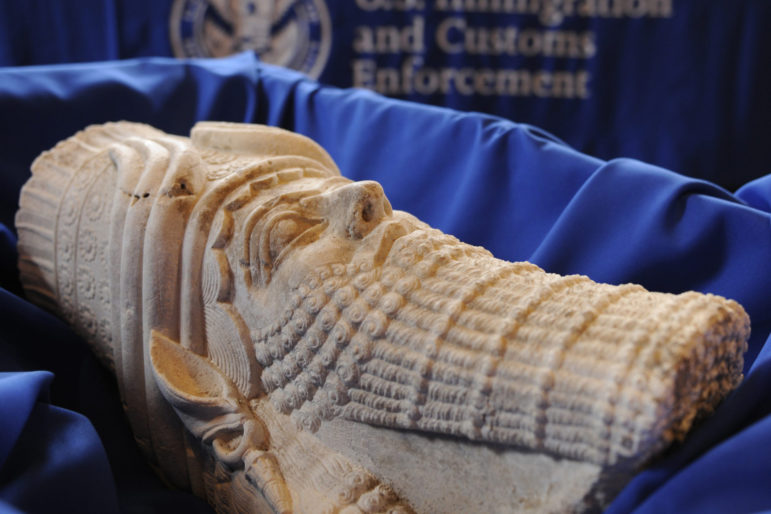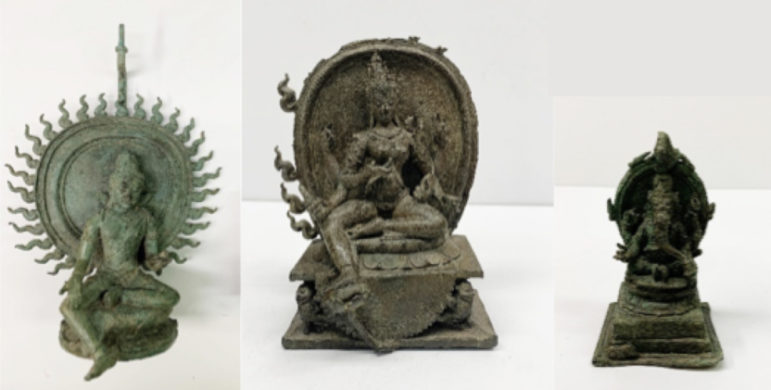NEW YORK – In his 2004 book, Stealing History, Roger Atwood described the systematic identification, infiltration, and destruction of archeological sites to loot their riches and place them into the black market of antiquities trading. In many ways, the book is a detective story that, rather than re-counting a murder, describes the demolition, even erasure, of an ancient culture.
“Looting robs a country of its heritage, but, even worse, it destroys everyone’s ability to know about the past,” the author writes. “Looting obliterates the memory of the ancient world and turns its highest artistic creations into decorations, adornments on a shelf.”
Atwood shows with clarity the complex network of looters, gravediggers, intermediaries, and smugglers all the way to the wealthy clientele looking for that one-of-kind artwork to highlight their sophistication and cultivate the envy of their peers. The book received praise from the art world as well anthropologists and archeologists around the world.
The problem has not abated in the last two decades.

A limestone statue depicting the head of the Assyrian King Sargon II, an eighth century B.C. ruler is one of more than 60 Iraqi cultural treasures illegally smuggled into the United States that were returned to the Republic of Iraq, the Department of Homeland Security said in Washington, March 16, 2015, as pictured in this undated handout photo provided by the U.S. Immigration and Customs Enforcement (ICE). Image credit: Kelly Lowery, U.S. Immigration And Customs Enforcement – Public Domain
A new campaign started late last year by the United Nations Educational, Scientific and Cultural Organization by (UNESCO) called “The Real Price of Art” hopes to dismantle the illicit trade of antiquities and cultural goods by educating both the public and the art community and reveal what they term as “the hidden face of art trafficking.”
In a report titled “How much for the soul of a nation,” UNESCO reports that the illicit trade in antiquities and cultural goods approached US$10 billion every year.
The report also stated, “The Real Price of Art campaign, in some cases, the looting of archaeological sites, which fuels this traffic, is highly organized and constitutes a major source of financing for criminal and terrorist organizations.”
Audrey Azoulay, UNESCO Director-General adds that, “Illicit trafficking is a blatant theft of the memory of peoples. Raising awareness and calling for the utmost vigilance is necessary to fight this largely under-recognized reality.”
The new campaign marks the 50th anniversary of the 1970 Convention on the Means of Prohibiting and Preventing the Illicit Import, Export and Transfer of Ownership of Cultural Property that “urges States Parties to take measures to prohibit and prevent the illicit trafficking of cultural property. It provides a common framework for the States Parties on the measures to be taken to prohibit and prevent the import, export and transfer of cultural property.”
The convention was the culmination of a 20-year effort to create an international treaty to combat the illicit trafficking of cultural property.
“UNESCO’s mission is to spark worldwide interest in the fight against this illicit traffic in cultural property, through actions that contribute to raising international awareness,” said Sunna Altnoder, head of the Movable Heritage and Museums Unit at UNESCO in Frame. “In recent years, illicit trafficking has increased exponentially, and this phenomenon has been worsened during the health crisis.”
But the illegal trade of antiquities and cultural property is more lucrative than ever.
“The craze for these objects, the prices of which have skyrocketed; the leniency of sanctions and the vulnerability of sites in conflict zones are all challenges that need to be addressed to curb the trafficking of what some call ‘blood antiquities’,” writes UNESCO’s Agnès Bardon in the UNESCO Courier.
Interacting with law enforcement agencies around the world, tens of thousands of illicit cultural property has been seized. However, the COVID-19 pandemic has worsened the problem and extended the challenge to interdict on antiquities trading.
The Antiquities Trafficking and Heritage Anthropology Research (ATHAR) Project, is a team of anthropologists and heritage experts specializing in digital networks for art trafficking, observed a resurgence in the trade of cultural objects, particularly those from the Middle East and North Africa.
Just this afternoon, the Customs administration at Cairo International Airport seized 34 antique coins in the possession of a passenger. The coins are from different historical periods, dating as far back as the 1,200s CE. Secretary-General of the Supreme Council of Antiquities, Dr. Mostafa Waziri, explained that as soon as the Archaeological Units Center became aware of the coins, they were seized by the airport authorities and the passenger detained.

Pictured (from left to right): Seated Shiva, Seated Parvati, and Seated Figure of Ganesha. Image via Manhattan District Attorney
Meanwhile, in a separate study in the Journal of Computer Applications in Archaeology, researchers used open-source intelligence to scour posts and texts to analyze “excavation and illicit trafficking of archaeological goods (and forgeries) across the Balkan-Eastern Mediterranean region(s) of Bosnia and Herzegovina, Croatia, Kosovo, Montenegro, North Macedonia, Serbia and Slovenia.”
The study uses social network analysis, a statistical technique that identifies the structure of relationships across individuals to find nodes of information and specific actors within the framework that moves information, and ultimately physical objects, around.
The research “shows how artefact-hunters target sites, features and objects; reveal the objects that are collectible and/or marketable; acquire equipment; form patron-client relationships, peer-to-peer partnerships and other cooperative groups; engage in transnational activity; crowdsource techniques for smuggling; crowdsource ways to avoid being caught or punished; and respond to policing.”
The Organized Crime and Corruption Reporting Project (OCCRP), a global network of investigative journalists publishing stories, and exposing crime and corruption, noted that Balkans is indeed a nexus for Middle East trade of illicit cultural artefacts into Wester Europe.
“It’s one of those places where there are archaeological remains from a lot of societies that are interesting to powerful collectors in more powerful countries,” criminologist Sam Hardy told the OCCRP. “It’s clear that lots of stuff is coming out of the ground as well as the material which is being funneled through the country.”
Last month, a London art restorer Neil Perry Smith was extradited to the United States and indicted by the Manhattan District Attorney for an alleged smuggling conspiracy also involving jailed art dealer Subash Kappor.
“Without restorers to disguise stolen relics, there would be no laundered items for antiquities traffickers to sell,” said Manhattan District Attorney Cy Vance Jr. “The arraignment of Neil Perry Smith serves as a reminder that behind every antiquities trafficking ring preying upon cultural heritage for profit, there is someone reassembling and restoring these looted pieces to lend the criminal enterprise a veneer of legitimacy. Thanks to our Antiquities Trafficking Unit and our partners at HSI, Smith will now face justice on U.S. soil, and we look forward to seeing alleged ringleader Subhash Kapoor inside of a Manhattan courtroom in the near future. In the meantime, we will continue to pursue these cases vigorously and return these stolen items to the countries from which they were stolen.”
The stolen items that included a seated Shiva, seated Parvati and seated figure of Ganesha have now been repatriated to Indonesia, Australia, and India. The Manhattan DAs office said that it has returned 393 antiquities to 11 nations in the past 12 months including the now-famous “coffee table” from the Nemi ships.
The Wild Hunt is not responsible for links to external content.
To join a conversation on this post:
Visit our The Wild Hunt subreddit! Point your favorite browser to https://www.reddit.com/r/The_Wild_Hunt_News/, then click “JOIN”. Make sure to click the bell, too, to be notified of new articles posted to our subreddit.